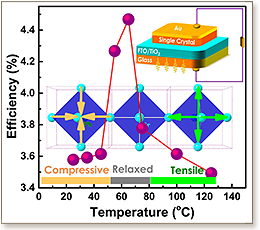

 Hybrid organic-inorganic perovskite crystals have recently become one of the most important classes of photoactive materials in the solar cell and optoelectronic communities. Albeit improvements have focused on state-of-the-art technology including
various fabrication methods, device architectures, and surface passivation, progress is yet to be made in understanding the actual operational temperature on the electronic properties and the device performances. Therefore, the substantial effect
of temperature on the optoelectronic properties, charge separation, charge recombination dynamics, and photoconversion efficiency are explored. The results clearly demonstrated a significant enhancement in the carrier mobility, photocurrent, charge
carrier lifetime, and solar cell performance in the 60 ± 5 °C temperature range. In this temperature range, perovskite crystal exhibits a highly symmetrical relaxed cubic structure with well-aligned domains that are perpendicular to a principal
axis, thereby remarkably improving the device operation. This finding provides a new key variable component and paves the way toward using perovskite crystals in highly efficient photovoltaic cells.
Hybrid organic-inorganic perovskite crystals have recently become one of the most important classes of photoactive materials in the solar cell and optoelectronic communities. Albeit improvements have focused on state-of-the-art technology including
various fabrication methods, device architectures, and surface passivation, progress is yet to be made in understanding the actual operational temperature on the electronic properties and the device performances. Therefore, the substantial effect
of temperature on the optoelectronic properties, charge separation, charge recombination dynamics, and photoconversion efficiency are explored. The results clearly demonstrated a significant enhancement in the carrier mobility, photocurrent, charge
carrier lifetime, and solar cell performance in the 60 ± 5 °C temperature range. In this temperature range, perovskite crystal exhibits a highly symmetrical relaxed cubic structure with well-aligned domains that are perpendicular to a principal
axis, thereby remarkably improving the device operation. This finding provides a new key variable component and paves the way toward using perovskite crystals in highly efficient photovoltaic cells.